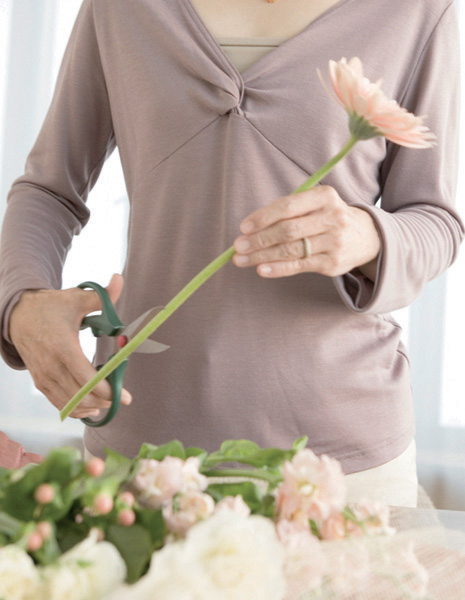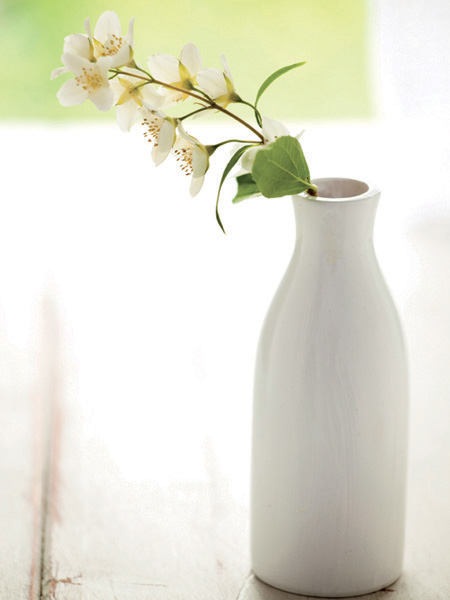
A bouquet of flowers isn’t just for young lovers or celebrations—the right floral decoration can bring a room to life. Take advantage of garden flowers to create beautiful displays in summer, and use dried flowers and arrangements to add an elegant, welcoming touch in winter.
Flowers are an attractive addition to any room. Whether placed in a corner or used as a centerpiece, they add color and rich scents everyone can enjoy.
A fresh bouquet of cut flowers looks lovely. Use these traditional tips to prolong enjoyment of them for as long as possible.
• Gather cut flowers only during dry weather. Snip open blooms in the morning and those that haven’t yet opened in the evening.
• Put flowers into a bucket of lukewarm water up to the petals immediately after picking. Before you arrange them in a vase, cut the stems again.
• Spray cut flowers with water occasionally to keep them fresh in the heat of summer.
• Lengthen the life of flowers with a milky sap (such as milkweed and poppies) by dipping the stems in boiling water for 10 seconds to cauterize them.
• Gently remove all lower leaves from the stem so none will be immersed in the vase water.
• When flowers begin to wilt, shorten the stems by about 1–11/2inches (2.5–4 cm) and put them in hot water, using a paper towel to protect the blooms from the steam. Then move them to deep, cold water for 1 hour before arranging them in the vase again.
• Use wire or tape to provide extra support for the stems of bent flowers.
CUT STEMS ON AN ANGLE so that more water is ABSORBED.
Floating garden
Decorative bowl
Water
Flowers or leaves
Stones
Fill the bowl with water and add the flowers or leaves. To keep the stems underwater, weigh them down with stones. Rub the big leaves with a little vegetable oil so they shine. You can even add a little aromatic oil to the water to enrich the fragrance.
• Hang freshly cut flowers (tied together in small bouquets) upside down in a dry, well-ventilated room. The stems will thin as they dry, so you may have to tighten the strings. After about 3 weeks, use the flowers for a wreath or other arrangement.
• Dry flowers with glycerin to preserve their shape and suppleness, although their color will probably change. Roses, peonies and anemones are good candidates. Pour one part glycerin and two parts boiling water into a tall, narrow container. Cut the flowers on an angle and place them 3–4 inches (8–10 cm) deep in the solution. Store the container in a cool place until glycerin drops appear on the leaves.
• Dry flowers such as marigolds, peonies and carnations with silica gel crystals from a craft store. Shorten the stems to about 2 inches (5 cm) and stick them on a blunt wire. Spread the silica gel on the bottom of an airtight container. Lay the flowers on top, cover with 1–11/4 inches (2–3 cm) silica gel and place the closed container in a warm place for 2 days.
• Use silica sand to preserve the shape and color of zinnias, marigolds and orchids. Place the flowers in a tightly sealed container with a 2 inch (5 cm) layer of sand. Be sure the flowers don’t touch each other—once dry, they can’t be separated. Close the container tightly, taping it shut, and set it aside for about 10 days. You can reuse the sand as long as you let it dry at 200–250°F (100–120°C) in the oven.
Beautiful floral arrangements can be fashioned out of both fresh and dried flowers, but never combine more than five different types of flowers.
1 Add the greenery first, then the tallest flowers (for structure) in the center and at the sides. Use odd numbers of flowers for the most pleasing effect.
2 Next, add the shorter filler flowers; distribute them evenly. Opt for a simple dome-shaped arrangement that will look beautiful from all sides.
3 Add more visual interest with trailing greenery that droops over the edge of the vase or container.
• Use moss with fresh flower arrangements, since you will need to moisten it regularly.
• Pebbles or marbles can add a decorative touch to an arrangement in a tall vase.
• To keep wild flowers from wilting, insert the stems into plastic bags filled with water and tie them up.
Creating floral arrangements
1 Get some floral foam from a local florist and soak it thoroughly. Cover it with moss (from florists or florists’ suppliers) and wrap it tightly with wire.
2 Beginning at the center, carefully insert the selected flowers. As a rule, flowers that appear together in nature tend to harmonize well in floral arrangements.
3 Attach decorative elements such as colored eggs, berries or fruit using florist’s wire or toothpicks.
When you are creating flower displays, it’s important to consider the vessel in which you are placing them.
• Use an attractive bottle for a single, tall flower.
• A wooden frame turns into a living picture if you drill holes in the bottom for test tubes; fill the tubes with a continually replenished display of fresh flowers.
• Native flowers, cornflowers and other informal arrangements look good in woven baskets lined with watertight plastic.
• Terra-cotta pots make rustic but pretty containers for many types of flowers and branches. Line them so that moisture doesn’t leach through. It’s even better to place a small vase inside that’s hidden from view.
• Pewter harmonizes with peach-colored petals.

Flowers and context will determine the type of vase.